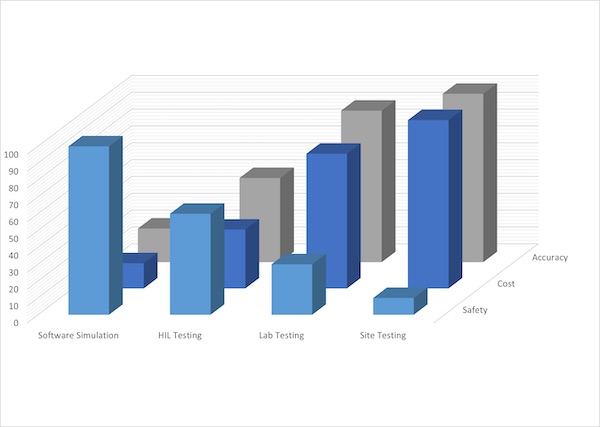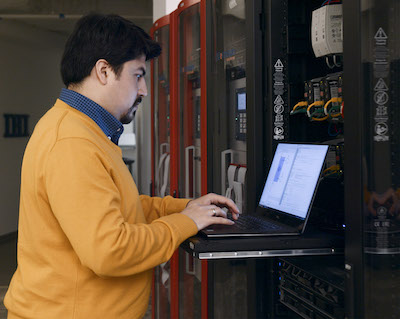Leveraging Multilevel Simulation and Testing to Minimize BESS Risk
Battery Energy Storage Systems (BESS) projects are systems of systems: a collection of individual components that have their own software, connectors, and operational requirements. These systems must interface with other components that have different software and operational requirements., all of which creates an incredible level of complexity a system integrator must address.
Experienced system integrators with in-house simulation programs can reduce operational and commissioning risks by testing BESS component interaction, communication, and potential failure points prior to project installation on site.

There are different simulation environments that allow testing prior to Commercial Operation Date (COD). Each simulation has different tradeoffs for cost, safety, and accuracy. A robust simulation plan should include multi-faceted testing, which should range from the easily repeatable and automated, to the difficult to automate but highly accurate.
Common methods for evaluating operability of BESS projects include Software-Only, Hardware-in-the-Loop (HIL) Simulation, Lab Testing, and On-Site Testing. System integrators can perform all of these common methods alone or in tandem, but each has its strengths and weaknesses.
|
Method |
Strengths |
Weaknesses |
|
Software-Only |
|
|
|
Hardware-in-the-Loop (HIL) simulation |
|
|
|
Lab Testing |
|
|
|
On-Site Testing |
|
|
Table 1. Comparison between methods of evaluating operability of BESS projects through simulation
Software-only simulation
Software-only simulation models are inexpensive to create and set up for test, but they are only as accurate as the equipment specifications, which may not align to real system performance in the field. This simulation environment works well to test communication and connectivity between different modules and parts of the system. It is most useful where high flexibility and rapid reconfiguration are needed or desired.
Hardware in Loop (HIL) simulation testing
 HIL testing bridges the gap between software-only and lab-scale testing using the automation and flexibility of software simulation with the accuracy and performance of real project hardware. When set up correctly to emulate site conditions, HIL systems can enable microsecond-level electrical simulation between real control boards from batteries, inverters, and meters and power plant control hardware developed by the integrator. They provide the communication bridge between battery management system software, inverter controls, meter readouts, system faults and alarms, and the power plant controller’s logic.
HIL testing bridges the gap between software-only and lab-scale testing using the automation and flexibility of software simulation with the accuracy and performance of real project hardware. When set up correctly to emulate site conditions, HIL systems can enable microsecond-level electrical simulation between real control boards from batteries, inverters, and meters and power plant control hardware developed by the integrator. They provide the communication bridge between battery management system software, inverter controls, meter readouts, system faults and alarms, and the power plant controller’s logic.
This not only allows real-time simulation of typical operations, but also provides a sandbox for testing system responses to electrical and communication faults, evaluating behavior across different functional modes and diagnosing problems encountered in system operation. Since the HIL system can simulate high impact fault conditions such as over temperature faults or IGBT failures, there are no impacts to real hardware or personnel safety while performing these tests.
For battery energy storage systems already in service, the HIL system can serve as an additional level of software validation before updates and firmware upgrades from OEMs are rolled out into the field.
Lab testing
Lab testing rigs can provide accurate results, but can only be done on a small amount of equipment. Labs require a large amount of space for the containerized BESS products and expensive dedicated systems that must be updated frequently, which may or may not be easy to reconfigure for different projects.
Onsite testing
Site equipment testing gives real system responses, but prohibits fault simulation because of the risk of damage to equipment and system downtime. Site test is also the most dangerous and costly, as the energy transferred is real and not simulated.
Providers with simulation and modelling experience, and multilevel testing capability in a variety of simulation environments, can help reduce risk to the project and increase operational certainty for the power plant owners and operators.
Michael Stebbins is L3 Simulation Engineer, and Jared Spence is Sr. Product Manager at IHI Terrasun Solutions, an energy storage integrator with proprietary power plant software and in-house field services team. With almost a decade of energy storage development experience, the company focuses primarily on large scale BESS projects.
IHI Terrasun Solutions | www.ihiterrasun.com
Author: Michael Stebbins and Jared Spence
Volume: 2023 November/December









